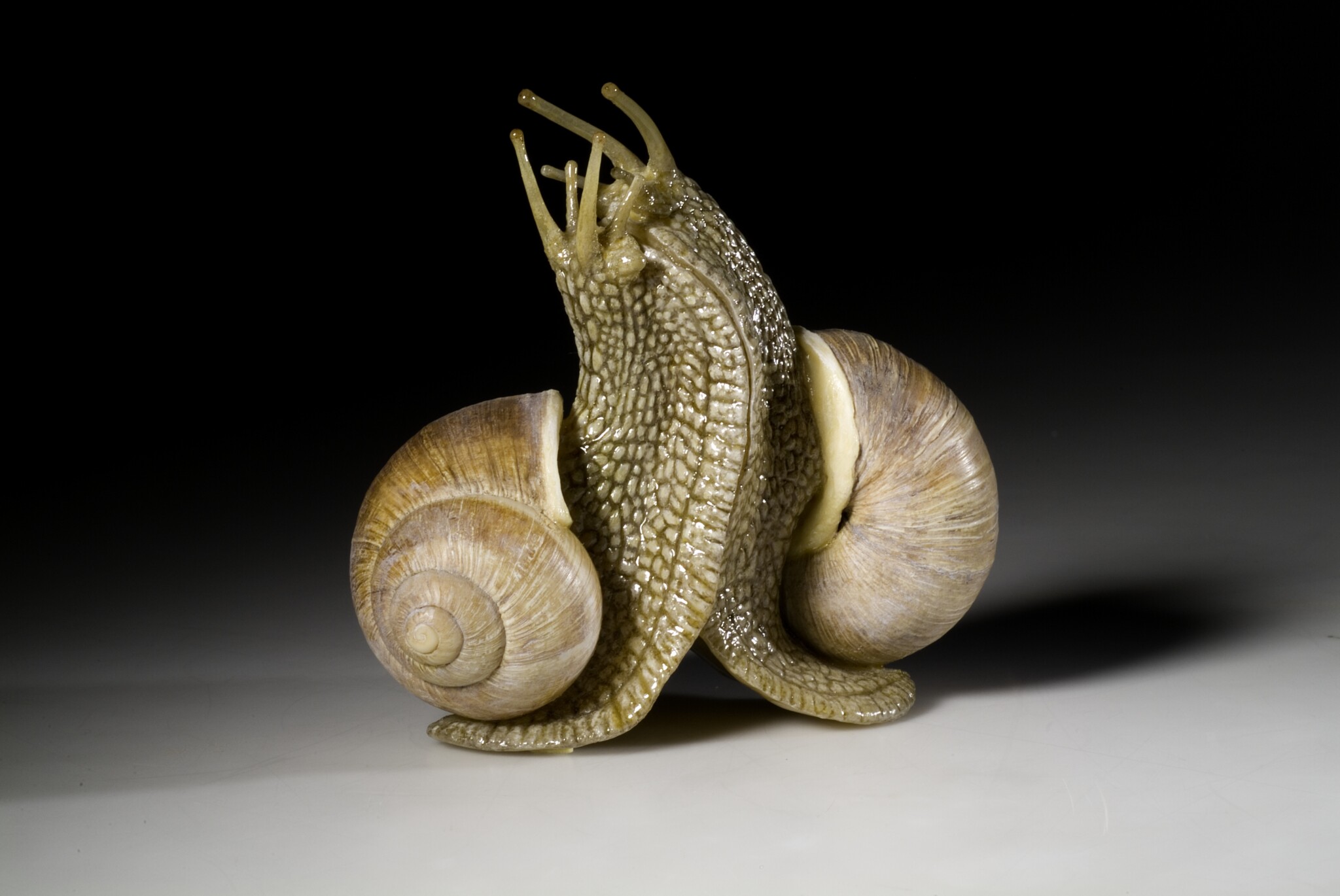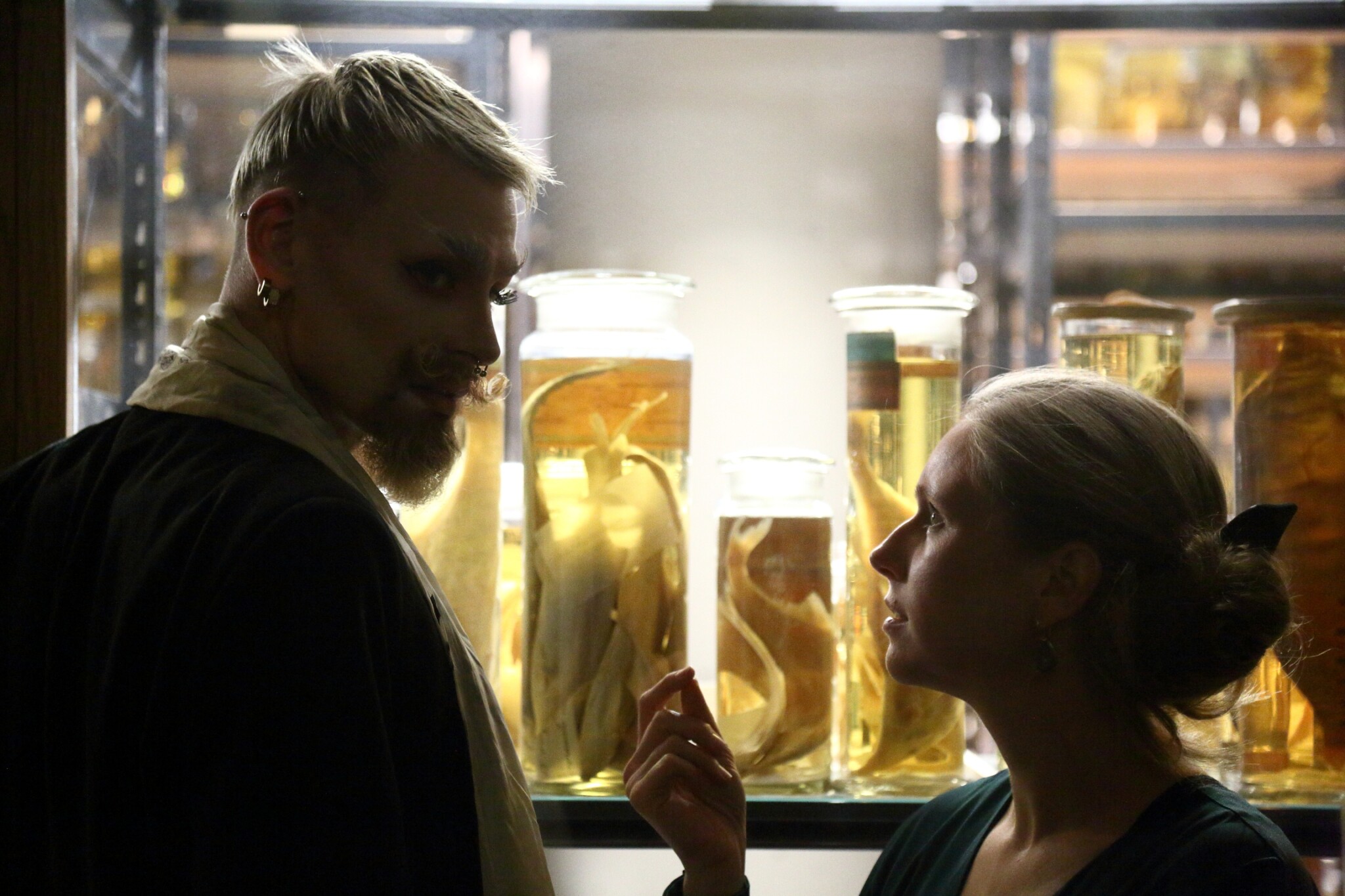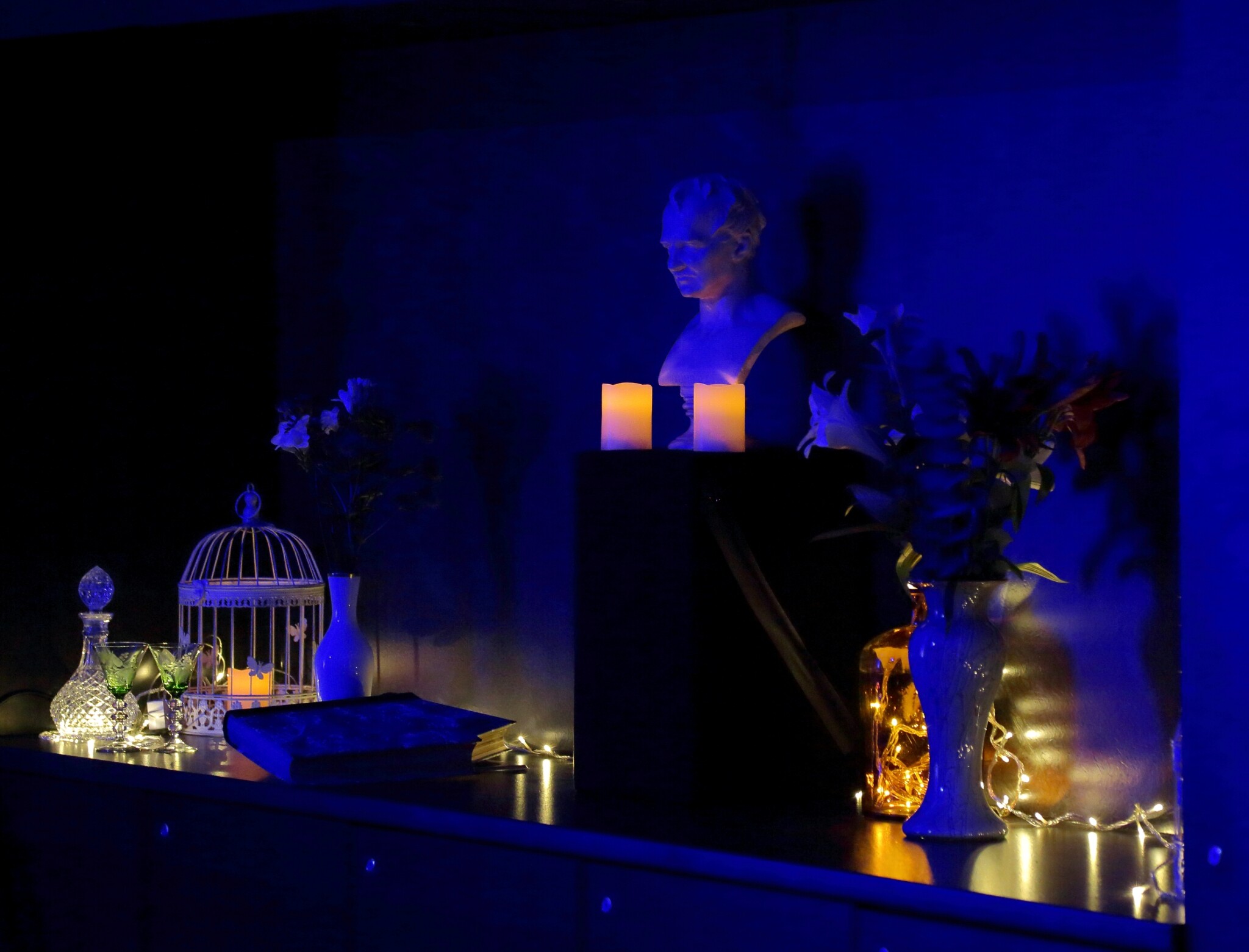Ines Theileis and David Ziegler in conversation with Anna-Sophie Jürgens | Interviews / Circus & Science
Abstract: Glitzern & Denken is the Science Variety Show hosted by the Museum für Naturkunde Berlin, the natural history museum in Germany’s capital. In this conversation, Ines Theileis and David Ziegler – the show’s artistic director and project lead – discuss the vision and goal of the Science Variety, and the power of the variety format for bringing art and science together. They reflect upon their collaboration with scientists and artists, and the special kind of knowledge emerging from these collaborations.
Ines Theileis, you are a freelance artist, classic singer and founder of the Ensemble Salon Fähig (an ensemble of diverse artists from Berlin’s independent scene). David Ziegler, you are a science communicator and researcher at the Museum für Naturkunde. Together, as artistic director and project lead, you started Glitzern & Denken, the museum’s Science Variety Show. Glitzern & Denken is a joint project by Museum für Naturkunde Berlin, the Ensemble Salon Fähig and the German science communication agency Wissenschaft im Dialog (WiD), funded by the LOTTO-Stiftung Berlin. According to your website, your show – which will be streamed live in English on 11.11.2020 (https://youtu.be/a9YQHITxS4s) and is jointly developed by artists and scientists – combines “art with science and underground with high culture”. In your own words, how would you introduce this show to the readers of our journal?
David: Glitzern & Denken is literally translated to glittering and thinking. The glitter stands for joy, curiosity and fascination, while the thinking stands for, well, thinking, analysis and understanding. We want to build bridges between emotion and rationality. In order to achieve this goal, we bring artists and scientists on stage together.
Our forthcoming show is titled Slimy! It is dedicated to snails, octopuses and clams, which together form the phylum of molluscs. In this show, biological facts will be combined with interesting stories and cultural knowledge, and interwoven with music and artistic performances. For example, we are going to explore how snails show up in literature and pop culture or why a tiny octopus from the museum’s collection was coined vampire squid (although it doesn’t drink blood).

Who had the idea to create this show – and why? Why is it important to bring science and art together through performance?
Ines: Some years ago I had the vision to encourage people to think about more complicated subjects and to have fun with that. For me using my brain is a great sport. I would like to have more of that kind of amusement with all kinds of people – and a variety show seemed to me the most profound way to realize this. A variety show is entertaining; you expect the unexpected and the unbelievable. Everything seems possible – even thinking with joy.
David: The museum’s mission is discovering and describing life and earth – with people, through dialogue. We aim to be an innovative communication platform for nature. In this context, the Science Variety is a great opportunity to experiment with the interaction of performing arts and science. The museum has created a testing ground – a sort of experimental lab – for various formats of research communication and participatory approaches, through the Experimental Field for Participation and Open Science (https://www.museumfuernaturkunde.berlin/en/museum/exhibitions/experimental-field-participation-and-open-science). The Experimental Field is the larger context of our Variety.

As we have learned from previous projects and activities, an artist’s perspective can greatly enrich our understanding of what we do in the scientific field. For us, this is a way to open up the museum and provide new ways of interacting with our scientific work. We build on former projects combining arts and science, for example the Art/Nature project [Kunst/Natur Projekt] (http://kunst.naturkundemuseum-berlin.de/), which featured art interventions in the museum’s exhibition. In 2017, an international conference exploring the relationship between art and scientific collection was part of this programme. Expanding on these interests and experiences in Glitzern & Denken, we focus on the performing arts and strive to find out how they can contribute to the museum’s mission.
The vision of the show is to promote the dialogue between culture, science and society. Why did you choose the variety format and how does it enable a deeper understanding of both the art forms involved and the sciences and collaborations that unfold in your shows?
Ines: We are performers, musicians and acrobats who know how to work with a live audience, how to build an atmosphere and amazement. We use these skills to present and frame the content the scientists want to communicate. There is a lot of space for unconventional humour and plain silliness in this format. The other thing is that we can show scientists as great human beings with virtuous skills, comparable to a professional musician or acrobat. We value talents, abilities and the will to develop them over quite some time. From this starting point of amazement, we build a new perspective on scientific subjects.
How would you define the relationship between the idea and ‘mission’ of your show and science communication?
David: The mission of our show is creating a space that allows you to perceive scientific content with pleasure and joy. By interacting with the emotional side of human beings – our shows address and approach science themes through wonder, awe and humour – we open up different cognitive pathways for scientific knowledge. We believe this is a promising way of reaching out to new target groups for science communication, especially young adults with an established interest in arts and culture, but little interest in science. We want to show that scientific content can be experienced in a fascinating and aesthetic way at the museum.
A way to do this is by telling interesting stories about science, scientists and also pop culture, science culture and science history. In our blog, we collect stories dealing with these interactions. For example, we stumbled across a snail collection of the poet H. C. Andersen, who wrote tales like The Little Mermaid [Die kleine Meerjungfrau] (https://www.glitzerndenken.blog/feature-kopenhagen). The collection can be seen at the Natural History Museum of Denmark and our colleagues in Copenhagen told us some very interesting things about the poet and his motivation for collecting snail shells. However, they stated quite clearly that although there is some public interest for this collection, it is mostly irrelevant from a scientific perspective. Our colleagues have to undertake a lot of investigative work, combining the data and meta-data from different historic collections, in order to get a modern-day scientific value out of them. This is a good example of the complex interaction between scientific knowledge, human interest and the way we communicate about it.
How have the previous shows of the Scientific Variety been received by your community at the museum, other scientists and artists?
Ines: For the artists and the audience that already knew us, I can say that they learned a great deal for themselves, and continue to speak about the subjects we discussed on stage. For example, my artist colleagues have more awareness for the sound of the nightingale after we did a show about these birds.
When there is a newspaper article about some of the featured scientific concepts or the problems they analyse – e.g. biodiversity loss – it seems that the ability of the shows’ participants to become aware and to understand grows. This is exciting. The world we see gets bigger … A good example can be found in our first show (https://www.youtube.com/watch?v=K7m9ig5LFmc), which explains the scientific concept of taxonomy and also its limits through a dialogue between a scientist and an artist.
David: The scientists who have participated in the shows so far report that the collaboration with artists opened up a different perspective on their own fields. Also, they seem to have enjoyed being on a glittering variety stage, which is quite different from the more sober stage of a scientific conference. The audience has given us very positive feedback so far. For the museum’s established visitor community, our shows aim to present the museum in a way that is new to them.

What criteria do you use to put together your programme and how do you find and/or select the artists and scientists who participate?
Ines: In the beginning, I asked the museum – and I always ask the scientists – what information they want the audience to go home with. From this point, I start figuring out with my ensemble what kind of music and weirdness to add to the science. I do this because humans do not really listen to the expected and conventional. We feel like we already know this, we feel that this is familiar and somewhat boring. But it’s surprising, what can happen, when a queer clown asks the silly question everyone has on the tip of their tongue but fears to ask – no one should think they are stupid. A clown and a scientist can have a talk that starts with a silly question and ends up in a fascinating discussion about an aspect of scientific work one wouldn’t have seen before. And because of the entertaining irritation in the beginning, people start to listen. Join our next show – which will be streamed on 11 November 2020 (see here) – to get an idea of what our show looks like.
How would you define the cooperation between the artists and scientists in relation to your science show? How do artistic and scientific activities work together? Or, in other words, what are the interactions between the two areas?
Ines: Artists and scientists spend time together. This is unusual and enriching for them. They have many discussions; together they research, rehearse and produce videos, and finally they perform together. And, it’s one of the big privileges in this work. Both sides need to figure out a basis for communication. When their wit and humour do not match, then what? We all need to figure a way out of the situation, and in that moment we all learn a great deal as we find new ways to explain complicated subjects – and then we find the punchlines … In this process we learned that some of the best punchlines came from the scientists. We as the artists just build a frame for their charm (e.g. https://www.youtube.com/watch?v=tpn0oARYMN8&feature=emb_logo).

What artistic results have these collaborations led to?
Ines: There are many. One result was me singing with nightingales, as I mentioned earlier. Right now, we plan to sing for a snail – we really hope she likes opera! In our first show at the museum, we combined poems written by scientists about the subject of taxonomy with a hula hoop performance by the great Phillip Golle (https://youtu.be/K7m9ig5LFmc?t=565 ).
We have also a lot of unusual conversations. When scientist and artists see each other in their abilities, new thoughts can appear. Sometimes a clown and a political theorist can have profound thoughts on the same subject. They share their views and thus add something to the others’ view of the world.
The artists stand as active performers on stage in different projects, they bring their skills to this project. We cast them for the skills they are able to perform on stage. We also cast them for their persona. Me, personally, I’m a singer. Of course I do sing elsewhere, and I use the songs I develop for the museum elsewhere. But, I also use work I did before for an underground circus show (https://www.youtube.com/watch?v=clyKgOfErNE) in our new show at the museum (not the whole thing but the basic attitude).
What influence does the science dimension have on the artists?
Ines: It’s fascinating to see how much the content of the shows becomes part of our lives. We add this new knowledge to our everyday lives. Here is an example: I love reading weird books about science. In my opinion, there is some genuine weirdness in science history. I can have a great laugh with Pliny the Elder (https://en.wikipedia.org/wiki/Pliny_the_Elder). Meanwhile, my co-host Philip has a new desire: acquiring a pet Albino Giant African snail …
To what extent do scientists benefit from working with artists?
David: As I mentioned earlier, participating in the show seems to enable the scientists to see their area of study with new eyes and approach it in a different way. Also, they discover new ways of talking about their field, in a different, maybe more informal way, guided by the principles of storytelling rather than the principles of scientific report. Here, we explore an interface between variety and rhetoric and vocal performance. And, spoken plainly, most of them said it was great fun working with the artists!

Does a special kind of knowledge emerge from these collaborations?
David: I think the new kind of knowledge we create in this process is a new way of speaking about science. This new way is more emotional and therefore “closer” to the world of the audiences. We hope that scientific information, especially about nature, becomes more relevant to people’s everyday live and assists people in making better choices for our common future.
Ines: Every change of perspective holds new thoughts for all of us. There are things we haven’t been able to see yet because of our societal structures. As a society, we historically come from a class system and our modern democracy is pretty young. I don’t think that our traditions help, if they are not adapted. For example, in the past nobility and also the educated middle classes understood knowledge as a power tool that needed to be protected and was used to „keep the lower classes out”. What if we change that? I would love to find out!
The stories science tells us become new ones if they are told from a bunch of very diverse perspectives. Hopefully, we can help to build some more sensible and sustainable narratives for our future.
David and Ines, thank you for this wonderful conversation!
Picture above the text: Stage set of Glitzern & Denken(2020. Photo: Stefan Tietz.
How to cite this article
Anna-Sophie Jürgens (2020): Glitzern & Denken: The Scientific Variety Show at the Museum für Naturkunde Berlin. w/k–Between Science & Art Journal. https://doi.org/10.55597/e6593


Be First to Comment